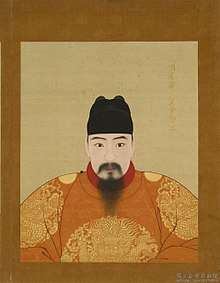Hongzhi Emperor
| Hongzhi Emperor 弘治帝 | |||||||||||||||||
|---|---|---|---|---|---|---|---|---|---|---|---|---|---|---|---|---|---|
 | |||||||||||||||||
| 10th Emperor of the Ming dynasty | |||||||||||||||||
| Reign | 22 September 1487 – 8 June 1505 | ||||||||||||||||
| Coronation | 22 September 1487 | ||||||||||||||||
| Predecessor | Chenghua Emperor | ||||||||||||||||
| Successor | Zhengde Emperor | ||||||||||||||||
| Born | 30 July 1470 | ||||||||||||||||
| Died | 8 June 1505 (aged 34) | ||||||||||||||||
| Burial | Tailing, Ming tombs, Beijing | ||||||||||||||||
| |||||||||||||||||
| House | House of Zhu | ||||||||||||||||
| Father | Chenghua Emperor | ||||||||||||||||
| Mother | Empress Xiaomu (Lady Ji 纪氏) | ||||||||||||||||
The Hongzhi Emperor (Chinese: 弘治; pinyin: Hóngzhì) (30 July 1470 – 9 June 1505) was the tenth emperor of the Ming dynasty in China between 1487 and 1505. Born Zhu Youcheng[1][2], he was the eldest surviving son of the Chenghua Emperor and his reign as emperor of China is called the "Hongzhi Silver Age". His era name, "Hongzhi", means "great government." A peace-loving emperor, the Hongzhi Emperor also had only one empress and no concubines, granting him the distinction of being the sole perpetually monogamous emperor in Chinese history, besides Emperor Fei. He was emperor during the middle years of the Ming dynasty.[3]
Early years
Zhu Youcheng was born to Lady Ji (纪氏) and was raised in secret by his mother, the abandoned Empress Wu, and various eunuchs who swore secrecy to not expose Zhu Youcheng and upset Emperor Chenghua's favourite concubine Lady Wan, who was trying to conceive a child of her own. Lady Wan's own child died shortly after birth; Lady Wan would order any pregnancies to be forcibly aborted and eliminated any concubines. Zhu Youcheng was only then reunited with his father at the age of five in 1475 and was created crown prince. He had been a brilliant child early on and he received the best education offered at that time. He was immersed in Confucian schooling and he excelled in his studies.
Reign as emperor
After the Hongzhi Emperor ascended the throne in 1487, his administration was modeled after Confucian ideology and he became a hardworking and diligent emperor. He closely supervised all affairs of state, lowered taxes, reduced government spending and made wise decisions when employing ministers to government post. Individuals such as Liu Jian, Xie Qian and Wang Shu worked hand in hand with the Hongzhi Emperor, thus creating a seldom-witnessed atmosphere of cooperation within the government. In addition, the emperor also encouraged his ministers to be up front about all issues, even acknowledging criticisms directed towards the emperor himself. This created a more transparent government and introduced fresh energy into the Ming dynasty. As a result, the populace once again prospered under his rule. It was said that individual eunuchs' power was curtailed and palace intrigues, prevalent in previous reigns, were absent during his reign. The Hongzhi Emperor has been compared to the Hongwu Emperor and Yongle Emperor as one of the most brilliant emperors of the Ming dynasty.
In the spring of 1488, the shipwrecked Korean crew of the Jeju-do official Choe Bu (1454–1504) were traveling up the Grand Canal while escorted by the Ming courier service en route back to Korea. Choe observed ferry ships passing by holding officials who were from the Ministries of War, Justice, and Personnel.[4] When he asked what was going on, it was explained to him that the new Hongzhi Emperor was ridding his government of corrupt and incompetent officials, and this was a final gesture of good will by the emperor by providing them with a comfortable passage back home by ship.[4]
Succession crisis
Unlike almost all of his predecessors and successors who took up many concubines which bore many children to the emperor, the Hongzhi Emperor had only one Empress during his lifetime. Coupled with the fact that Empress Zhang had only two sons (one of whom died in infancy), the Hongzhi Emperor was left with only one nominee to succeed him. After the emperor died in 1505, he was succeeded by his son, the Zhengde Emperor. Unfortunately, the Zhengde Emperor died childless in 1521 and the throne had to be passed to a cousin from Hubei named Zhu Houcong, effectively ending the Hongzhi Emperor's own line of succession.
Family
- Parents:
- Zhu Jianshen (憲宗 朱見深; 1447 – 1487)
- Posthumous empress Ji (孝穆皇后 紀唐妹; 1451 – 1475), personal name Tangmei
- Consorts and Issue:
- Empress Zhang (孝成敬皇后 張氏; 1471 – 1541)
- Zhu Houzhao (武宗 朱厚照; 1491 – 1521)
- Princess Taikang (太康公主 朱秀榮; 1494 – 1498), personal name Xiurong
- Zhu Houwei (蔚悼王 朱厚煒; 1495 – 1496)
See also
References
- Brook, Timothy. (1998). The Confusions of Pleasure: Commerce and Culture in Ming China. Berkeley: University of California Press. ISBN 0-520-22154-0
Hongzhi Emperor Born: 30 July 1470 Died: 8 June 1505 | ||
| Regnal titles | ||
|---|---|---|
| Preceded by The Chenghua Emperor |
Emperor of China 1487–1505 |
Succeeded by The Zhengde Emperor |